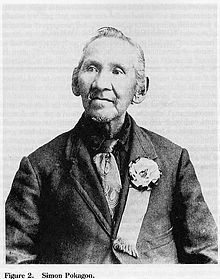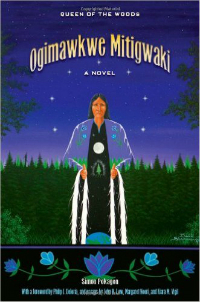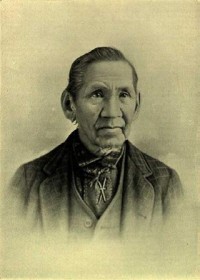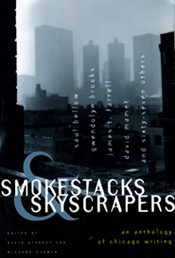 Simon Pokogan (1830-1899) was born in Berrien County, Michigan, the son of Leopold Pokogan, chief of the Potawatomies for more than 40 years. In 1832 Leopold, some believe, actually sold the land some of early Chicago was built on. Simon attended Oberlin College for a year and Twinsburg Institute, near Cleveland, for two, then served as chairman of the Potawatomi business committee. A controversial middleman figure to his own people, Pokagon on the one hand advocated for the Potawatomi community, often elegantly expressing the Native sadness of displacement and castigating whites for usurping their land. On the other hand, he seemed a tireless self-promoter and was criticized for, among other things, selling the tribe’s interest in the Chicago lakefront by way of quitclaim—an echo of his father’s earlier sale?—and too readily acquiescing to white demands.
Simon Pokogan (1830-1899) was born in Berrien County, Michigan, the son of Leopold Pokogan, chief of the Potawatomies for more than 40 years. In 1832 Leopold, some believe, actually sold the land some of early Chicago was built on. Simon attended Oberlin College for a year and Twinsburg Institute, near Cleveland, for two, then served as chairman of the Potawatomi business committee. A controversial middleman figure to his own people, Pokagon on the one hand advocated for the Potawatomi community, often elegantly expressing the Native sadness of displacement and castigating whites for usurping their land. On the other hand, he seemed a tireless self-promoter and was criticized for, among other things, selling the tribe’s interest in the Chicago lakefront by way of quitclaim—an echo of his father’s earlier sale?—and too readily acquiescing to white demands.
 Nevertheless, Simon Pokogan is an important early Native American literary figure, often referred to as the “Indian Longfellow” for his many poems. He is also usually credited with being the first Native American to write a novel about Native Americans, Queen of the Woods/O-Gi-Maw-Kwe Mi-Tig-Wa-Ki (1899), though some scholars believe it was actually ghostwritten by his publisher, an indication of how he perhaps allowed himself to be used by whites promoting the noble savage image.
Nevertheless, Simon Pokogan is an important early Native American literary figure, often referred to as the “Indian Longfellow” for his many poems. He is also usually credited with being the first Native American to write a novel about Native Americans, Queen of the Woods/O-Gi-Maw-Kwe Mi-Tig-Wa-Ki (1899), though some scholars believe it was actually ghostwritten by his publisher, an indication of how he perhaps allowed himself to be used by whites promoting the noble savage image.
“In early life, I was deeply hurt as I witnessed the grand old forests of Michigan, under whose shades my forefathers lived and died, falling before the cyclone of civilization as before a prairie fire,” reads a typical passage in Queen of the Woods. He contrasts the wild birds of old—who sang natural, varied songs—with “the songs of other birds that have come with the advance of civilization,” birds who “sing in concert, without pride,” and sing “alike”—that is, without deep purpose or connection—whether they are “in forest and field,” “before wigwam or caste,” or “before savage, or sage…chief or king,”
 In his Red Man’s Rebuke he can be found writing: “On behalf of my people, the American Indians, I hereby declare to you, the pale-faced race that has usurped our lands and homes, that we have no spirit to celebrate with you the great Columbian Fair now being held in this Chicago city, the wonder of the world. No; sooner would we hold the high joy day over the graves of our departed than to celebrate our own funeral, the discovery of America. And while…your hearts in admiration rejoice over the beauty and grandeur of this young republic and you say, ‘behold the wonders wrought by our children in this foreign land,’ do not forget that this success has been at the sacrifice of our homes and a once happy race.”
In his Red Man’s Rebuke he can be found writing: “On behalf of my people, the American Indians, I hereby declare to you, the pale-faced race that has usurped our lands and homes, that we have no spirit to celebrate with you the great Columbian Fair now being held in this Chicago city, the wonder of the world. No; sooner would we hold the high joy day over the graves of our departed than to celebrate our own funeral, the discovery of America. And while…your hearts in admiration rejoice over the beauty and grandeur of this young republic and you say, ‘behold the wonders wrought by our children in this foreign land,’ do not forget that this success has been at the sacrifice of our homes and a once happy race.”
While these words characterize him as a great early spokesperson of resistance for Native American peoples, on the other hand his speech on “Chicago Day” at that very World’s Columbian Exposition—where he supposedly had “no spirit to celebrate”—had a decidedly conciliatory tone. The October 10, 1893, edition of the Chicago Daily Tribune reports him as saying: “I shall cherish as long as I live the cheering words that have been spoken to me here by the ladies, friends of my race; it has strengthened and encouraged me; I have greater faith in the success of the remaining few of my people than ever before. I now realize the hand of the Great Spirit is open in our behalf; already he has thrown his great search light upon the vault of heaven, and Christian men and women are reading there in characters of fire well understood, ‘The red man is your brother, and God is the father of all.’”
 In our book Smokestacks and Skyscrapers: An Anthology of Chicago Writing, David Starkey and I included an excerpt from his famous account of the massacre at Fort Dearborn, where he urges readers to consider “the real causes” of the “massacre”—“the great Algoquin tribe, with others” being “slowly but surely pushed before the tidal wave of civilization towards the setting sun…,” despite the fact that when the whites “reached out their hands for wido-kaw-ke-win [help]…we filled them with wie-aus and maw-daw-min [meat and corn].” He dismisses accusations such as the Patowatomies pretending “to be acting as escorts for the soldiers, when, in fact, they were luring them to their death.”
In our book Smokestacks and Skyscrapers: An Anthology of Chicago Writing, David Starkey and I included an excerpt from his famous account of the massacre at Fort Dearborn, where he urges readers to consider “the real causes” of the “massacre”—“the great Algoquin tribe, with others” being “slowly but surely pushed before the tidal wave of civilization towards the setting sun…,” despite the fact that when the whites “reached out their hands for wido-kaw-ke-win [help]…we filled them with wie-aus and maw-daw-min [meat and corn].” He dismisses accusations such as the Patowatomies pretending “to be acting as escorts for the soldiers, when, in fact, they were luring them to their death.”
“Disguise the fact as the pride of the white man may,” he writes, “when he joins hands with unaltered savages in warfare he is a worse savage than they,” then accuses the white man of making the Indian worse. “All our traditions and the accounts published by the dominant race show conclusively that the white man’s dealing with our fathers was of such a character that they were made worse.” He recalls his father Leopold’s belief in the enormous corrosive effect of “fire water.” It is an impassioned defense. Yet even here his references to “unaltered savages,” his admission that Native Americans were “made worse,” and the way he often seems to identify civilization with whiteness—all these lean towards confirming that Native Americans may indeed be less worthy. He also seemed to think that his appeals could break through the “pride of the white man,” something that history has amply proven otherwise.
♦ Read about other Native American writers and artists: Metea, Mark Turcotte, Ramson Lomatewama.
♦ Go to a list of Chicago Writers, most included in Smokestacks and Skyscrapers.